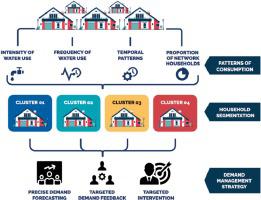Resources, Conservation and Recycling ( IF 13.2 ) Pub Date : 2021-07-18 , DOI: 10.1016/j.resconrec.2021.105792 Halidu Abu-Bakar , Leon Williams , Stephen H Hallett

|
Characterising individual households’ consumption patterns reliably and ascertaining the extent to which these patterns change and how they underpin aggregate demand continues to present a challenge. This paper presents an empirical characterisation of household water consumption patterns, based on consumer segmentation, to improve the accuracy of demand forecasting and to develop both proactive and responsive water conservation strategies. Medium resolution smart metre data for 2019 for 10,000 households were analysed using Machine Learning (ML), revealing four household clusters whose significant differences are underpinned by a variety of indicators in their temporal consumption patterns. The clusters, labelled according to the predominant peak demand times of constituent households, are ‘Evening Peaks’ (EP), ‘Late Morning’ (LM), ‘Early Morning’ (EM) and ‘Multiple Peaks’ (EP). Some of the significant findings include the fact that on average households in EM only record one peak event in 24 h, compared with the MP clusters’ four peak events, with 2 in every 5 households in MP having a confirmed internal leak compared with 1 in every 5 for the other three clusters. A total of 31,788 Cubic metres (m3) was consumed, constituting a monthly mean of 2,649m3, equating to a per household consumption (PHC) of ~270 litres per household per day (l/h/d). Results also revealed the clusters’ distributed dominance of hourly demand and the most active clusters in different seasons. The paper concludes that identifying the significant differences characterising consumption patterns and their concomitant impact on network demand will not only serve to enhance demand forecasting and the prediction of geographical consumption hotspots but will also allow the delivery of targeted intervention measures according to households’ shared characteristics.
中文翻译:

经验水消费者细分和支撑需求高峰的消费模式特征
可靠地表征单个家庭的消费模式并确定这些模式的变化程度以及它们如何支撑总需求仍然是一项挑战。本文基于消费者细分,提出了家庭用水模式的实证特征,以提高需求预测的准确性,并制定主动和响应性的节水策略。使用机器学习 (ML) 分析了 2019 年 10,000 个家庭的中等分辨率智能电表数据,揭示了四个家庭集群,其显着差异是由其时间消费模式中的各种指标支撑的。根据组成家庭的主要需求高峰时间标记的集群是“晚间高峰”(EP)、“晚间”(LM)、“清晨”(EM)和“多峰”(EP)。一些重要发现包括,与 MP 集群的四个峰值事件相比,EM 中的家庭平均在 24 小时内仅记录一个峰值事件,MP 中每 5 个家庭中就有 2 个确认内部泄漏,而在其他三个集群每 5 个。共 31,788 立方米 (m3 ) 的消耗量,月平均值为 2,649m 3,相当于每户每天消耗约 270 升 (l/h/d) 的家庭消耗量 (PHC)。结果还揭示了集群每小时需求的分布优势和不同季节最活跃的集群。本文得出的结论是,识别消费模式的显着差异及其对网络需求的伴随影响,不仅有助于加强需求预测和地理消费热点的预测,还有助于根据家庭的共同特征采取有针对性的干预措施。



























 京公网安备 11010802027423号
京公网安备 11010802027423号